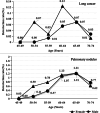Assessing factors influencing participation in LDCT lung cancer screening among high-risk urban populations in Nanjing, China
- PMID: 40691785
- PMCID: PMC12278565
- DOI: 10.1186/s12885-025-14589-9
Assessing factors influencing participation in LDCT lung cancer screening among high-risk urban populations in Nanjing, China
Abstract
Background: Lung cancer remains a leading cause of cancer-related mortality in urban China, underscoring the urgency of effective screening programs. Despite the proven efficacy of low-dose computed tomography (LDCT) in reducing lung cancer mortality, participation rates among high-risk populations remain suboptimal. This study aspired to determine factors influencing LDCT screening adherence among high-risk individuals in Nanjing, China, as part of the China Urban Cancer Screening Project (CanSPUC).
Methods: A cross-sectional study was conducted from 2019 to 2023, involving 52,910 participants aged 45-74 years. High-risk individuals were identified using a modified Harvard Risk Index adjusted for Chinese demographics. Socio-demographic and clinical data were collected via questionnaires and LDCT reports, with missing values imputed via random forest models. Logistic regression was used to determine the factors associated with LDCT screening adherence.
Results: Among 16,020 high-risk participants, only 45.4% (7,280/16,020) underwent LDCT. Key factors influencing participation included gender (OR = 1.36, 95% CI:1.24-1.49, p < 0.001), education level (OR = 1.18, 95%CI:1.10-1.26, p < 0.001), occupational exposure (OR = 1.20, 95%CI: 1.11-1.29, p < 0.001), current smoking (OR = 1.26, 95%CI:1.13-1.40, p < 0.001), family cancer history (OR = 1.37, 95%CI:1.28-1.46, p < 0.001), and tuberculosis history (OR = 0.84, 95%CI:0.72-0.97, p = 0.022). LDCT detected lung cancer in 0.47% (34/7,280), with semi-positive nodules observed in 43.16% (3,142/7,280) of screened individuals.
Conclusions: Despite effective risk stratification, participation in LDCT screening remains low in urban China. Targeted interventions to solve gender disparities, health literacy gaps, and risk communication may be very important to improve the intake rate. Perhaps future efforts should give priority to community-based education, enhanced accessibility, and tailored protocols to reduce lung cancer mortality in high-risk populations.
Keywords: Adherence; Early detection; High-risk population screening; LDCT; Lung cancer.
© 2025. The Author(s).
Conflict of interest statement
Declarations. Ethics approval and consent to participate: This study was approved by the Ethics Committee of Jiangsu cancer Hospital (Approval No.KY-2024-030). All procedures were performed in accordance with the ethical standards of the institutional and national research committees and the 1964 Declaration of Helsinki and its later amendments or comparable ethical standards. All patients signed informed consent prior to participant. Consent for publication: Not applicable. Competing interests: The authors declare no competing interests.
Figures
Similar articles
-
Impact of low-dose computed tomography (LDCT) screening on lung cancer-related mortality.Cochrane Database Syst Rev. 2022 Aug 3;8(8):CD013829. doi: 10.1002/14651858.CD013829.pub2. Cochrane Database Syst Rev. 2022. PMID: 35921047 Free PMC article.
-
The probability of lung cancer in patients with pulmonary nodules detected via low-dose computed tomography screening in China.BMC Cancer. 2025 Jul 1;25(1):1058. doi: 10.1186/s12885-025-14449-6. BMC Cancer. 2025. PMID: 40597901 Free PMC article.
-
Impact of the COVID-19 pandemic on lung cancer screening utilization and outcome: a health examination center retrospective study.Ann Med. 2025 Dec;57(1):2525398. doi: 10.1080/07853890.2025.2525398. Epub 2025 Jun 28. Ann Med. 2025. PMID: 40580117 Free PMC article.
-
Opportunistic Screening With Low-Dose Computed Tomography and Lung Cancer Mortality in China.JAMA Netw Open. 2023 Dec 1;6(12):e2347176. doi: 10.1001/jamanetworkopen.2023.47176. JAMA Netw Open. 2023. Retraction in: JAMA Netw Open. 2024 Sep 3;7(9):e2438532. doi: 10.1001/jamanetworkopen.2024.38532. PMID: 38085543 Free PMC article. Retracted.
-
Smoking cessation interventions within the context of Low-Dose Computed Tomography lung cancer screening: A systematic review.Lung Cancer. 2016 Aug;98:91-98. doi: 10.1016/j.lungcan.2016.05.028. Epub 2016 Jun 1. Lung Cancer. 2016. PMID: 27393513
References
-
- Leiter A, Veluswamy RR, Wisnivesky JP. The global burden of lung cancer: current status and future trends. Nat Rev Clin Oncol. 2023;20(9):624–39. - PubMed
-
- Zhou J, Xu Y, Liu J, Feng L, Yu J, Chen D. Global burden of lung cancer in 2022 and projections to 2050: incidence and mortality estimates from GLOBOCAN. Cancer Epidemiol. 2024;93: 102693. - PubMed
-
- Cancer - Screening. and early detection https://www.who.int/europe/news-room/fact-sheets/item/cancer-screening-a...
MeSH terms
Grants and funding
LinkOut - more resources
Full Text Sources
Medical



